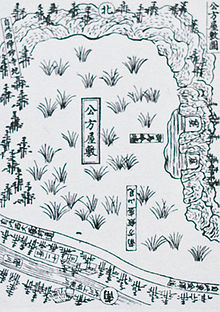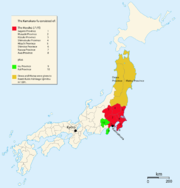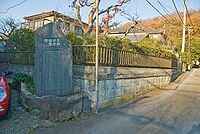
Kanto kubo
Encyclopedia

Shogun
A was one of the hereditary military dictators of Japan from 1192 to 1867. In this period, the shoguns, or their shikken regents , were the de facto rulers of Japan though they were nominally appointed by the emperor...
assumed by Ashikaga Motouji
Ashikaga Motouji
-See also:* Kamakura, Kanagawa - The Muromachi and Edo periods* The article Nanboku-chō period...
after his nomination to Kantō kanrei
Kanrei
or, more rarely, kanryō, was a high political post in feudal Japan; it is usually translated as Shogun's Deputy. After 1349, there were actually two Kanrei, the Kyoto Kanrei and the Kantō Kanrei....
, or deputy shogun for the Kamakura-fu
Kamakura-fu
The or was a regional government installed in Kamakura, in today's Kanagawa Prefecture, by the Ashikaga shogunate which lasted from 1349 to 1455. It was headed by a dynasty of Ashikaga rulers called Kamakura Kubō...
, in 1349. Motouji transferred his original title to the Uesugi family
Uesugi clan
The was a Japanese samurai clan, descended from the Fujiwara clan and particularly notable for their power in the Muromachi and Sengoku periods ....
, which had previously held the hereditary title of , and would thereafter provide the Kantō kanrei. The Ashikaga had been forced to move to Kyoto, abandoning Kamakura
Kamakura, Kanagawa
is a city located in Kanagawa Prefecture, Japan, about south-south-west of Tokyo. It used to be also called .Although Kamakura proper is today rather small, it is often described in history books as a former de facto capital of Japan as the seat of the Shogunate and of the Regency during the...
and the Kantō region
Kanto region
The is a geographical area of Honshu, the largest island of Japan. The region includes the Greater Tokyo Area and encompasses seven prefectures: Gunma, Tochigi, Ibaraki, Saitama, Tokyo, Chiba, and Kanagawa. Within its boundaries, slightly more than 40 percent of the land area is the Kantō Plain....
, because of the continuing difficulties they had keeping the Emperor and the loyalists under control (see the article Nanboku-chō period). Motouji had been sent by his father, shogun Ashikaga Takauji
Ashikaga Takauji
was the founder and first shogun of the Ashikaga shogunate. His rule began in 1338, beginning the Muromachi period of Japan, and ended with his death in 1358...
, precisely because the latter understood the importance of controlling the Kantō region
Kanto region
The is a geographical area of Honshu, the largest island of Japan. The region includes the Greater Tokyo Area and encompasses seven prefectures: Gunma, Tochigi, Ibaraki, Saitama, Tokyo, Chiba, and Kanagawa. Within its boundaries, slightly more than 40 percent of the land area is the Kantō Plain....
and wanted to have an Ashikaga ruler there, but the administration in Kamakura
Kamakura, Kanagawa
is a city located in Kanagawa Prefecture, Japan, about south-south-west of Tokyo. It used to be also called .Although Kamakura proper is today rather small, it is often described in history books as a former de facto capital of Japan as the seat of the Shogunate and of the Regency during the...
was from the beginning characterized by its rebelliousness, so the shogun's idea never really worked and actually backfired. After Motouji, all the kubō wanted power over the whole country, and the Kantō kubō era is therefore essentially a struggle for the shogunate between the Kamakura and the Kyoto branches of the Ashikaga clan. In the end, Kamakura had to be retaken by force by troops from Kyoto. The five kubō recorded by history, all of Motouji's bloodline, were in order Motouji himself, Ujimitsu
Ashikaga Ujimitsu
was a Nanboku-chō period warrior and the Kamakura-fu's second Kantō Kubō, or Shogun Deputy. Son of first Kantō Kubō Ashikaga Motouji, he succeeded his father in 1367 at the age of nine when this last suddenly died during an epidemic. It was during his reign that the Kanto Kubō title became common...
, Mitsukane
Ashikaga Mitsukane
was a Nanboku-chō period warrior, and the Kamakura-fu's third Kantō Kubō, . Being the eldest son, he succeeded his father Ujimitsu in 1398 at the age of 21 when he died during an epidemic.. Like him, Mitsukane aspired more or less openly to the shogunate and, like him and his successors, failed to...
, Mochiuji
Ashikaga Mochiuji
Ashikaga Mochiuji was the Kamakura-fu's fourth Kantō kubō during the Sengoku period in Japan. During his long and troubled rule the relationship between the west and the east of the country reached an all-time low. Kamakura was finally attacked by shogun Ashikaga Yoshinori and retaken by force...
and Shigeuji
Ashikaga Shigeuji
was a Muromachi period warrior and the Kamakura-fu's fifth and last Kantō Kubō . Fourth son of fourth Kubō Ashikaga Mochiuji, he succeeded his father only in 1449, a full decade after his death by seppuku. His childhood name was...
.
Birth of the Kantō kubō

Siege of Kamakura (1333)
The 1333 siege of Kamakura was a battle of the Genkō War, and marked the end of the power of the Hōjō clan, which had dominated the regency of the Kamakura shogunate for over a century...
, the first of the Ashikaga shoguns Ashikaga Takauji left the city for Kyoto
Kyoto
is a city in the central part of the island of Honshū, Japan. It has a population close to 1.5 million. Formerly the imperial capital of Japan, it is now the capital of Kyoto Prefecture, as well as a major part of the Osaka-Kobe-Kyoto metropolitan area.-History:...
in pursuit of Nitta Yoshisada
Nitta Yoshisada
was the head of the Nitta family in the early fourteenth century, and supported the Southern Court of Emperor Go-Daigo in the Nanboku-chō period, capturing Kamakura from the Hōjō clan in 1333....
. He left behind his 4-year-old son Yoshiakira
Ashikaga Yoshiakira
was the 2nd shogun of the Ashikaga shogunate who reigned from 1358 to 1367 during the Muromachi period of Japan. Yoshiakira was the son of the founder and first shogun of the Muromachi shogunate, Ashikaga Takauji....
as his representative in the trust of three guardians: Hosokawa Kiyouji, Uesugi Noriaki, and Shiba Ienaga. Because the three were related to him through blood or marriage, he believed they would keep Kantō loyal to him. This action however formally divided the country in two, giving the east and the west two separate administrations, both with similar rights to power. Not only both had Ashikaga rulers, but Kamakura, which until very recently had been the seat of a shogunate, was still capital of the Kantō, and independentist feelings were still strong among Kamakura samurai.
In 1349 Takauji called Yoshiakira to Kyoto replacing him with another of his sons, Motouji, to whom he gave the title of Kantō kanrei, or Kantō deputy. At first the territory under his rule, known as Kamakura-fu
Kamakura-fu
The or was a regional government installed in Kamakura, in today's Kanagawa Prefecture, by the Ashikaga shogunate which lasted from 1349 to 1455. It was headed by a dynasty of Ashikaga rulers called Kamakura Kubō...
, included just the eight Kantō
Kanto region
The is a geographical area of Honshu, the largest island of Japan. The region includes the Greater Tokyo Area and encompasses seven prefectures: Gunma, Tochigi, Ibaraki, Saitama, Tokyo, Chiba, and Kanagawa. Within its boundaries, slightly more than 40 percent of the land area is the Kantō Plain....
provinces (the ), plus Kai
Kai Province
, also known as , is an old province in Japan in the area of Yamanashi Prefecture. It lies in central Honshū, west of Tokyo, in a landlocked mountainous region that includes Mount Fuji along its border with Shizuoka Prefecture....
and Izu
Izu Province
was a province of Japan in the area of Shizuoka Prefecture. Izu bordered on Sagami and Suruga Provinces. Its abbreviated form name was .The mainland portion of Izu Province, comprising the Izu Peninsula is today the eastern portion of Shizuoka Prefecture and the Izu Islands are now part of...
. Later, Kantō Kubō Ashikaga Ujimitsu
Ashikaga Ujimitsu
was a Nanboku-chō period warrior and the Kamakura-fu's second Kantō Kubō, or Shogun Deputy. Son of first Kantō Kubō Ashikaga Motouji, he succeeded his father in 1367 at the age of nine when this last suddenly died during an epidemic. It was during his reign that the Kanto Kubō title became common...
was given by the shogunate as a reward for his military support the two huge provinces of Mutsu
Mutsu Province
was an old province of Japan in the area of Fukushima, Miyagi, Iwate and Aomori prefecture and the municipalities of Kazuno and Kosaka in Akita Prefecture...
and Dewa
Dewa Province
is an old province of Japan, comprising modern-day Yamagata Prefecture and Akita Prefecture, except for the city of Kazuno and the town of Kosaka. It was sometimes called .-Historical record:...
.
The shogun's deputy in the Kantō region had the vital task to keep it under control. Structurally, his government was a small scale version of Kyoto's shogunate, and had full judiciary and executive powers. Because the kanrei was the son of the shogun, ruled the Kantō and controlled the military there, the area was usually called Kamakura Bakufu (Kamakura Shogunate), and Motouji or Kamakura/Kantō Gosho, an equivalent title. When later the habit of calling kubō the shogun spread from Kyoto to the Kantō, the ruler of Kamakura came to be called Kamakura Kubō. The Kanrei title was passed on to the Uesugi hereditary shitsuji. The first time the title appears in writing is in a 1382 entry of a document called , under second Kubō Ujimitsu. This term had been first adopted by Ashikaga Takauji himself and its use therefore implied equality to the shogun. In fact, sometimes the Kanto Kubō was called Kantō Shogun.
Instability of the Kantō region
This inherently unstable double-headed power structure was made even more problematic by the continuous display of independence of the Kantō region. Kamakura had just been conquered and its desire of independence was still strong. Also, many of the Ashikaga in Kamakura had been supporters of the shogun's dead brother Ashikaga TadayoshiAshikaga Tadayoshi
was a general of the Northern and Southern Courts period of Japanese history and a close associate of his elder brother Takauji, the first Muromachi shogun. Son of Ashikaga Sadauji and of a daughter of Uesugi Yorishige, the same mother as Takauji, he was a pivotal figure of the chaotic transition...
, and resented Takauji's rule. Consequently, after Motouji's death, Kamakura made clear it didn't want to be ruled by Kyoto. The intentions of the Kantō Ashikaga were made crystal clear by their confiscation of the Ashikaga-no-shō, the family piece of land in Shimotsuke province
Shimotsuke Province
is an old province of Japan in the area of Tochigi Prefecture in the Kanto region. It was sometimes called or .The ancient capital of the province was near the city of Tochigi, but in feudal times the main center of the province was near the modern capital, Utsunomiya.-History:Different parts of...
that had given the name to the entire clan. Second kubō Ujimitsu and his descendants tried to expand their influence, causing a series of incidents. By the time of third shogun Yoshimitsu
Ashikaga Yoshimitsu
was the 3rd shogun of the Ashikaga shogunate who ruled from 1368 to 1394 during the Muromachi period of Japan. Yoshimitsu was the son of the second shogun Ashikaga Yoshiakira....
, the Kamakura branch of the Ashikaga clan was regarded with suspicion. Tension continued to mount until it came to a head between sixth shogun Yoshinori
Ashikaga Yoshinori
was the 6th shogun of the Ashikaga shogunate who reigned from 1429 to 1441 during the Muromachi period of Japan. Yoshinori was the son of the third shogun Ashikaga Yoshimitsu.-Shogunal succession:...
and fourth kubō Mochiuji. Mochiuji had hoped to succeed Ashikaga Yoshimochi
Ashikaga Yoshimochi
was the 4th shogun of the Ashikaga shogunate who reigned from 1394 to 1423 during the Muromachi period of Japan. Yoshimochi was the son of the third shogun Ashikaga Yoshimitsu....
as shogun, and was disappointed by seeing Yoshinori rob him of the post. To express his displeasure, he refused to use the new shogun's era name (nengō). In 1439 Yoshinori sent his army to the Kantō, and Mochiuji was defeated and forced to kill himself.
In 1449 Kyoto made one last effort to make the system work. Shigeuji, last descendant of Motouji, was nominated Kantō kubō and sent to Kamakura. The relationship between him and the Uesugi however was strained from the beginning and culminated with Shigeuji's killing of Uesugi Noritada, a murder that made the Kantō province fall into chaos. (See also the article Kyōtoku Incident
Kyotoku Incident
The Kyōtoku Incident was a long series of skirmishes and conflicts fought for control of the Kantō region of Japan in the 15th century. The conflict began in 1454 with the assassination of Uesugi Noritada by Kantō kubō Ashikaga Shigeuji. The Ashikaga, Uesugi, and other clans then leapt to battle,...
). In 1455 Shigeuji was deposed by Kyoto forces and had to escape to Koga in Shimōsa Province, from where he directed a rebellion against the shogunate. This was the end of the Kantō kubō. The title would survive, but effective power would be in the hands of the Uesugi.
Because he no longer was Kantō kubō, Shigeuji now called himself Koga kubō. In 1457 eighth shogun Ashikaga Yoshimasa
Ashikaga Yoshimasa
was the 8th shogun of the Ashikaga shogunate who reigned from 1449 to 1473 during the Muromachi period of Japan. Yoshimasa was the son of the sixth shogun Ashikaga Yoshinori....
sent his younger brother Masatomo with an army to pacify Kantō, but Masatomo was unable to even enter Kamakura. This was the beginning of an era in which the Kantō and Kamakura were devastated by a series of civil wars called the Sengoku period
Sengoku period
The or Warring States period in Japanese history was a time of social upheaval, political intrigue, and nearly constant military conflict that lasted roughly from the middle of the 15th century to the beginning of the 17th century. The name "Sengoku" was adopted by Japanese historians in reference...
.
The Kantō kubōs residence in Kamakura

At the location of the former Kantō kubō residence in Kamakura stands a black memorial stele, whose inscription reads:
After Minamoto no Yoritomo
Minamoto no Yoritomo
was the founder and the first shogun of the Kamakura Shogunate of Japan. He ruled from 1192 until 1199.-Early life and exile :Yoritomo was the third son of Minamoto no Yoshitomo, heir of the Minamoto clan, and his official wife, a daughter of Fujiwara no Suenori, who was a member of the...
founded his shogunate
Kamakura shogunate
The Kamakura shogunate was a military dictatorship in Japan headed by the shoguns from 1185 to 1333. It was based in Kamakura. The Kamakura period draws its name from the capital of the shogunate...
, Ashikaga Yoshikane
Ashikaga Yoshikane
was a Japanese samurai military commander, feudal lord in the late Heian and early Kamakura period of Japan's history. He played an active part in the Jishō-Juei War and the later military campaign as a closely related person of the first Kamakura shogun Minamoto no Yoritomo, and made Ashikaga...
made this place his residence. His descendants also resided here for well over 200 years thereafter. After Ashikaga Takauji became shogun and moved to Kyoto, his son and second shogun Yoshiakira decided to also live there. Yoshiakira's younger brother Motouji then became Kantō kanrei and commanded his army from here. This became a tradition for all of the Ashikaga that followed. They, after Kyoto's fashion, gave themselves the title kubō. In 1455 kubō Ashikaga Shigeuji, after clashing with Uesugi Noritada
Uesugi clan
The was a Japanese samurai clan, descended from the Fujiwara clan and particularly notable for their power in the Muromachi and Sengoku periods ....
, moved to Ibaraki
Ibaraki, Ibaraki
is a town located in Higashiibaraki District, Ibaraki, Japan.The town was set to merge with Mito, Ibaraki on December 8, 2007, but following the election of a new mayor in April 2007, these plans were abandoned....
's Shimōsa and the residence was demolished.
Erected in March 1918 by the Kamakurachō Seinendan
Location: Jōmyōji 4-2-25, near Nijinohashi Bridge.
The location is near the bottom of an extremely narrow valley, and therefore easily defensible. The nearby Asaina Pass guaranteed an easy escape in case of a siege. According to the Shinpen Kamakurashi
Shinpen Kamakurashi
The is an Edo period compendium of topographic, geographic and demographic data concerning the city of Kamakura, Kanagawa Prefecture, Japan, and its vicinities. Consisting of eight volumes and commissioned in 1685 by Tokugawa Mitsukuni to three vassals, it contains for example information about...
, a guide book published in 1685, more than two centuries later after Shigeuji's escape, the spot where the kubō's mansion had been was still left empty by local peasants in the hope he may one day return.
See also
- Ashikaga shogunateAshikaga shogunateThe , also known as the , was a Japanese feudal military regime, ruled by the shoguns of the Ashikaga clan.This period is also known as the Muromachi period and gets its name from Muromachi Street of Kyoto where the third shogun Ashikaga Yoshimitsu established his residence...
- Kamakura-fuKamakura-fuThe or was a regional government installed in Kamakura, in today's Kanagawa Prefecture, by the Ashikaga shogunate which lasted from 1349 to 1455. It was headed by a dynasty of Ashikaga rulers called Kamakura Kubō...
- Kantō Kanrei
- Uesugi clanUesugi clanThe was a Japanese samurai clan, descended from the Fujiwara clan and particularly notable for their power in the Muromachi and Sengoku periods ....

